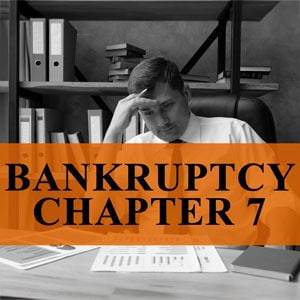
Separating Fact From Fiction: The Truth Behind 5 Common Chapter 7 Bankruptcy Myths
Bankruptcy, especially Chapter 7 liquidation, is often misunderstood and carries a heavy stigma. Misconceptions can lead to confusion and missed opportunities for relief. This article will shed light on five widespread Chapter 7 bankruptcy myths, particularly those affecting Maryland residents.
Keep reading to learn more about:
- Why almost anyone can benefit from bankruptcy depending on their circumstances.
- Why you may get to keep some of your belongings, and will still be able to buy a home despite bankruptcy.
- How bankruptcy in Maryland will affect you and your wife’s credit.
Myth #1: Is Filing For Bankruptcy Only For People With High Debt?
False. You don’t need to be drowning in hundreds of thousands of dollars of debt to consider bankruptcy. The key is whether the benefits of filing outweigh the costs.
For example, if filing will cost $2,000, it wouldn’t make sense for $1,000 of debt. But if you have $8,000 to $10,000 in debt and can get most of it wiped out? That’s a different story.
Clients of ours have ranged from having $6,000 to millions in debt—proving that bankruptcy isn’t just for extreme cases. It’s about finding what works best for your situation.
Myth #2: Will I Lose All My Personal Belongings In Chapter 7 Bankruptcy?
Partially true. Yes, Chapter 7 involves selling off some assets, but it doesn’t mean you’re left with nothing. Bankruptcy laws include exemptions that can help you keep essential and even some personal items.
Where you live—and where you’ve lived recently—affects what you can protect. In Maryland, and in some cases using federal exemptions, you might be surprised by how much you can keep.
When we meet to discuss your situation, we go through your assets and history so there are no surprises. We want you to feel in control and informed every step of the way. Our goal? To make sure you know exactly what, if anything, might be at risk before filing.
Myth #3: Does Filing For Chapter 7 Bankruptcy Mean I Will Never Own A Home Again?
False. The thought of never being able to own a home again can be daunting, but it’s not true. While bankruptcy affects your credit at first, it’s far from a permanent roadblock.
Many clients have bought homes three to four years after their bankruptcy closed, and some programs even allow purchases as soon as one year later if certain criteria are met.
Boosting your credit score with responsible use of credit and saving for a solid down payment can speed up your recovery. Homeownership after bankruptcy isn’t just possible—it’s achievable.
Myth #4: Does Chapter 7 Bankruptcy Stay On My Record For Life?
False. Chapter 7 bankruptcy remains on your credit report for up to 10 years, but that doesn’t mean your credit is doomed for a decade. The good news? You can start rebuilding your credit right away.
Simple steps like responsible credit card use and paying bills on time can greatly improve your score within two to three years. Lenders often care more about your current financial behavior than past filings. So, while the record stays visible, it doesn’t have to define you.
Myth#5: If I File For Chapter 7 Bankruptcy, Will It Affect My Spouse’s Credit?
Partially true. Filing for bankruptcy won’t touch your spouse’s credit unless they’re filing with you. However, if you share joint debts and you file alone, your spouse will still be responsible for those debts. If your debts are separate, your bankruptcy has no impact on their credit score. When there’s joint debt, consider filing together to avoid leaving your spouse burdened by creditors after your discharge.
Quick Takeaways To Remember
We have touched on some of the most common and problematic myths and misconceptions surrounding Chapter 7 bankruptcy, but there will always be more. Here are some quick and easy-to-remember pointers to keep in mind.
- Terrible credit for 10 years: FALSE.
- Lose all your assets: FALSE.
- Trouble finding a job: Mostly FALSE; exceptions apply to certain security-sensitive positions.
- Risk of job loss: FALSE.
- Unable to rent: FALSE. In fact, landlords often prefer a cleared bankruptcy to unresolved debt.
What’s Next? Let’s Talk.
These myth-busting insights are just the beginning. If they’ve given you a clearer perspective, that’s great – but to understand how bankruptcy could affect you, a personalized conversation is best. We offer a free 30-minute consultation where we’ll explore which options fit your unique situation, whether that’s Chapter 7, another type of bankruptcy, or a different solution altogether, like debt settlement or foreclosure defense.
Once you decide to move forward, we’ll walk you through every part of the process—from preparing your petition to preparing for the 341 meeting of creditors. We’ll make sure you’re confident and well-prepared, so nothing catches you off guard. And now that many meetings are conducted via Zoom, we’ll even help you get comfortable with the technology.
The goal is simple: make the process as smooth and stress-free as possible for you. Ready to learn more? Reach out for your consultation at (443) 492-9003. We’re here to help you take control of your financial future.
